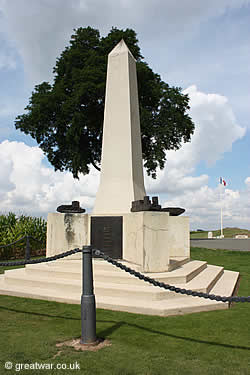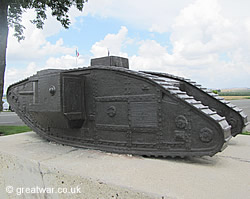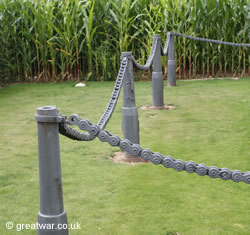Tank Corps Memorial, Pozières
Design & Unveiling

|
In 1919 the Tank Corps applied for permission to put up a memorial on this site. The Corps put forward a design for this site comprising a granite obelisk on a plinth with four models of tanks. Having successfully been accepted by the British Battle Exploit Memorials Committee and the French authorities' “Decret d'hommage publique” the application proceeded with the purchase of the plot of land from Monsieur Thibaut for about 750 Francs.(1)
Representing King George VI, the Tank Corps Memorial was unveiled by Lieutenant-General Sir Thomas L. N. Morland in July 1922.
Inscription
Two bronze plaques on the memorial are inscribed with the battles on the Western Front in France which the tanks participated in from September 1916 to the Armistice in November 1918:
“1916 — 1st SOMME — ANCRE ”
and
1918 —2nd SOMME — RIVER LYS — HAMEL — MARNE — MOREUIL — AMIENS — BAPAUME — ARRAS — EPEHY — CAMBRAI — ST. QUENTIN — SELLE — MORMAL FOREST”
First British Tank Action on the Western Front

|
This place on the Somme battlefield was selected as the place for the memorial because it was near this location that tanks first went into action with the British Army as a new, surprise weapon against the German Army in the First World War. A few miles south of this memorial tanks were used at the Battle of Flers-Courcelette (15th - 22nd September 1916).
In the night of 14th September a total of 36 tanks made their way to their allotted departure points for the launch of the British and French attack onto the German positions between Courcelette and Combles. Under a third of that number of tanks managed to make an impact on the German strongpoints, the others either breaking down, getting stuck or being knocked out. Although the battle resulted in high casualties for many of the British battalions taking part, and the majority of the tanks were not successful in reaching their objectives, there was a great moral boost reported by the British press with the capture of Flers combined with the played here by some of the tanks which did break through the German lines.
According to the British Official Military History “the scene in Flers was without precedent in war” (2) as tank D16 went forward into Flers village just before 8.20am. “Firing as it went, the tank lurched up the main street followed by parties of cheering infantry. Three other tanks (D6, D9 and D17) had begun to move along the eastern edge of the village, smashing into strongpoints and houses which contained machine guns, and spreading panic among the defenders who survived. Most of the Bavarians, however, had fled towards Gueudecourt, and although a few parties of desperate men held out for a time, all resistance was at an end by 10am.” (3) An air report at 8.43am to III Corps reported: “Tank seen in main street Flers going on with large number of troops following it.” (4)
The successful capture of Flers village in this battle and the first co-operation of this new tank weapon with an infantry and artillery assault was indeed inexperienced and in its early stages, but it was a glimpse of things to come.
Boundary Fence

|
An interesting feature of the memorial is the boundary “fence” around the obelisk. In the application to build the memorial the fence was suggested as a way of keeping cattle away from the plinth of the memorial. The boundary fence consists of ten upright 6 pounder tank gun barrels with tank driving chains mounted across them.
Location of the Tank Corps Memorial
The Tank Corps Memorial is located on the south side of the D929 Albert-Bapaume road just to the north of the village of Pozières.
Parking
There is a limited area of parking as a layby. This memorial is situated at the side of a very fast road and visitors are advised to take great care when moving about by parked vehicles. Children should be supervised here at all times.
Related Reading

Tanks and Trenches: First Hand Accounts of Tank Warfare in the First World War [Illustrated] [Paperback]
by David Fletcher
David Fletcher uses the extensive archive material and photographs held by The Tank Museum in Bovington, Dorset, to illustrate and explain the story of the tank in the First World War. He explains its early development, the first use on the battlefield at the Battle of Flers-Courcelette and how it continued in use through the battles of 1917 and 1918. Published by The History Press (23 Mar 2009). 192 pages. ISBN-10: 0752449362, ISBN-13: 978-0752449364
Tanks at Flers: An Account of the First Use of Tanks in War at the Battle of Flers-Courcelette, the Somme, 15 September 1916 [Hardcover]
by Trevor Pidgeon
This was the first of the late Trevor Pidgeon's books on the tanks in the First World War. It may be expensive if it is hard to find, but is a “must have” for any military historian to have in their library. Published by Fairmile Books (Sep 1995). 290 pages. ISBN-10: 0952517523, ISBN-13: 978-0952517528

Tanks on the Somme: From Morval to Beaumont Hamel [Hardcover]
by Trevor Pidgeon
The late Trevor Pidgeon has produced a number of masterful works of research into the tanks in the First World War, detailing the movements and histories of individual tanks in the various battles they fought in. Published by Pen & Sword Military (30 Aug 2010). 160 pages. ISBN-10: 1848842538, ISBN-13: 978-1848842533
Related Topics
The Tank Museum, Bovington, Dorset, England
Acknowledgements
(1) National Archives, Kew, document reference WO/5863
(2), (3), (4) Military Operations: France and Belgium, 1916 Volume II: 2 July 1916 to the end of the Battles of the Somme
